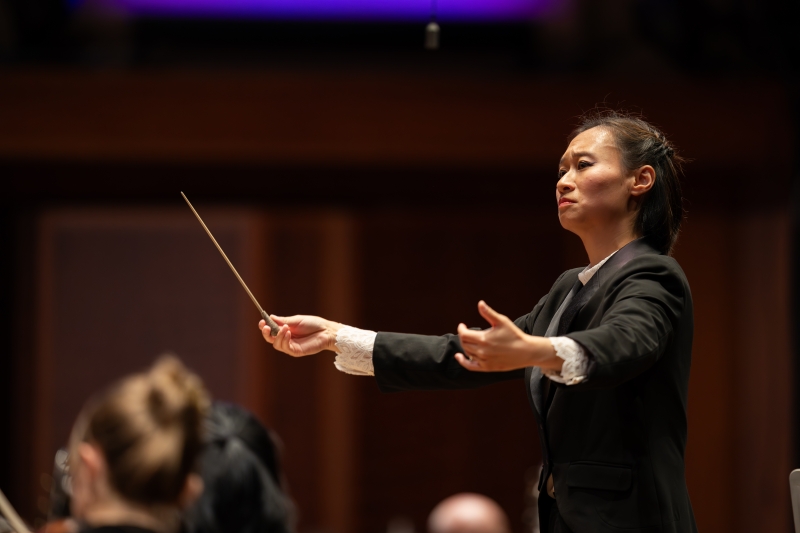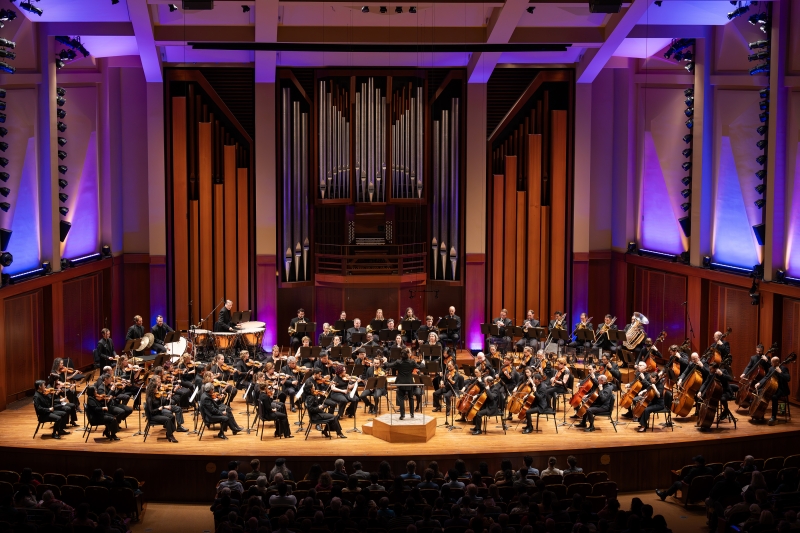Review: TCHAIKOVSKY SYMPHONY NO. 4 at Benaroya Hall
Tianyi Lu in Ravel and Tchaikovsky

The combination of Ravel and Tchaikovsky on the same program is a luxurious feast for any classical music lover. The Seattle Symphony treated a fervent Benaroya Hall audience to these delights on Sat., September 28, when conductor Tianyi Lu gave dramatic renderings of two major familiar works and another lesser-known piece that fit in perfectly with the atmosphere of the evening.
As a First Prize winner in the 2020 Sir Georg Solti Conducting Competition, Chinese born New Zealander Tianyi Lu often has been recognized as a high energy performer putting an innovative spin on the symphony repertoire. Her reputation led to high expectations, and she delivered that and more on the podium.

There is nothing lacking in Lu’s conducting. She is a major talent, a complete conductor in every sense. Watching her command of the orchestra, both gentle and forceful, was a pleasure. Her gestures were consistent, yet beautifully varied and nuanced. Her energy level was astonishing, and built to a frenzy by the end of the evening. The orchestra in turn responded with commensurate vitality and drive.
Finnish composer Kaija Saariaho’s Ciel d'hiver (Winter Sky) is an arrangement of the second movement of her Orion (2002), commissioned for the Théâtre du Châtelet in Paris and premiered in 2014. The piece was appealing, with plenty of atmosphere: a landscape from which to meditate on the forces of nature and the music of the spheres as they sweep through the starry night.
In her interpretation, Lu showed a deep commitment to bringing out the contemplative ambience of the work and its wintry elements: glistening drops of rain, harsh wind, and thunder. With an eerie opening, handsomely played by the piccolo, solo violin and strings, the stage was set for a chilly adventure that ultimately morphed into dissonance. Lu maintained the continuous flow needed to generate convincing coherence and bring the piece to a gentle close. Her gestures were precise, yet seemed to float on the air like the shimmering effects of the harp.
Ravel’s Piano Concerto in G, with its flash and wit, provided a huge contrast to the introspective Wintry Sky. Award winning pianist Alexandra Dariescu gave a debut performance that shone brightly: with panache, incisiveness and stylishness.
Dariescu, a child prodigy in her native Romania who emigrated to the UK as a teenager, was the first female Romanian pianist to perform at London’s Royal Albert Hall. She is also an educator, mentor and producer, known for groundbreaking innovation and such creative multimedia works as The Nutcracker and I. Her wide repertoire includes that of women composers Florence Price and Clara Schumann.

The pianist’s interpretation of the Ravel ranged from meticulous with an astonishingly delicate touch and great sensitivity, to technically showy and dramatic. She made the most of the contrasts between the sensational first and third movements and the wistful second movement. By the end of the technically challenging third movement, Dariescu had the audience demanding an encore. She complied with élan by performing Clara Schumann’s charming, dreamy Romanze in A-flat major, the second movement of the composer’s Piano Concerto. Dairescu’s performance was exquisite and mesmerizing, and appreciably enhanced by the gorgeously played solo cello obligato of principal cellist Efe Baltacıgil.
Tchaikovsky described his monumental Fourth Symphony as a battle with the inevitable forces of Fate and a reflection of Beethoven’s Fifth. From the opening declaration of the Fate motif in the Andante sostenuto of the first movement to the driving inexorable energy of the fourth movement, Finale: Allegro con fuoco, the work provides repeated opportunities for a conductor to shine.
Lu seized every moment with great attention to detail, generating energetic, impressive playing from each section of the orchestra that increased multifold as the piece progressed. The second movement, Andantino in modo di canzona, created a magical atmosphere, the oboe solo tastefully played. The brass, which was not quite up to its usual standard in the Ravel, came through with bold, attention-grabbing playing throughout the Tchaikovsky.

The concert ended with a finale that effectively blew off the roof of the hall: dynamic, powerful, and filled with Lu’s inspiring energy and force.
The performance was, in a word, superb.
Photo credits: Ben VanHouten
Reader Reviews
Videos

